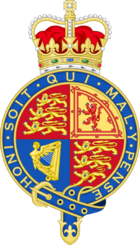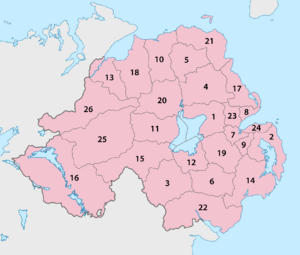Local Government (Boundaries) Act (Northern Ireland) 1971 facts for kids

|
|
| Long title | An Act to provide that Northern Ireland shall be divided into twenty-six local government districts and that each of those districts shall be divided into wards; to appoint a Commissioner to make recommendations regarding the boundaries and names of those districts and wards and the number of wards in each district; and for purposes connected therewith. |
|---|---|
| Citation | 1971 c. 9 |
| Dates | |
| Royal assent | 23 March 1971 |
| Other legislation | |
| Repealed by | Local Government (Boundaries) Act (Northern Ireland) 2008 |
| Relates to | Local Government Act (Northern Ireland) 1972, Local Government (Boundaries) (Northern Ireland) Order 2006 |
|
Status: Repealed
|
|
The Local Government (Boundaries) Act (Northern Ireland) 1971 was an important law passed in 1971 by the Parliament of Northern Ireland. This Act changed how local areas in Northern Ireland were managed. It replaced an older system that had been in place since 1898.
This new system was based on ideas from a special report called the Macrory Report, which came out in June 1970. The report suggested that Northern Ireland should have a strong regional government.
Contents
What was the Local Government (Boundaries) Act?
This Act decided that Northern Ireland would be split into 26 new areas called local government districts. Each of these districts would then be divided into smaller sections called wards.
The Act didn't draw the exact lines for these new districts right away. Instead, it listed 26 existing local areas that would be used as a starting point. The Governor of Northern Ireland was given the job of choosing a special person, called a Local Government Boundaries Commissioner. This Commissioner's task was to suggest the exact names and borders for these new districts and wards. They had to finish their work by June 30, 1972.
The Commissioner's ideas were officially put into action by another order, the Local Government (Boundaries) Order (Northern Ireland) 1972, which was made on July 17, 1972.
How did the New Districts Get Councils?
The 1971 Act created the new districts, but it didn't create the councils (groups of elected people) to run them. That part was handled by another law, the Local Government Act (Northern Ireland) 1972. The councils for these new districts officially started their work on October 1, 1973.
New Local Government Districts and Wards
The 1971 Act created 26 local government districts across Northern Ireland. These districts were designed to make local government more efficient. Each district was divided into a number of wards.
Initially, it was thought that each ward would elect one person to the district council. However, by the time the first elections happened on May 30, 1973, a different system was used. This new system, called proportional representation, grouped several wards together into "district electoral areas." Each of these areas would then elect several councillors.
These wards were also used for other purposes, like creating election areas for bigger government bodies and for collecting census information (like counting how many people live in an area).
Here are the original names of the 26 local government districts:
Changes and When the Act Ended
Over the years, there were some updates to the areas created by this Act.
- In 1985, the total number of wards in Northern Ireland increased from 524 to 562.
- Then, in 1993, the number of wards grew again to 582.
- Also in 1993, the ward of Rathfriland was moved from the Newry and Mourne district to the Banbridge district.
- There were also small changes to borders, like some rural parts of Legoniel moving from Belfast to Antrim in 1985.
Some district names also changed:
- In 1984, the district known as Londonderry was officially renamed Derry.
- In 1999, Dungannon District became Dungannon and South Tyrone.
Finally, the Local Government (Boundaries) Act (Northern Ireland) 1971 was replaced by a newer law, the Local Government (Boundaries) Act (Northern Ireland) 2008. This meant the 1971 Act was no longer in effect.


